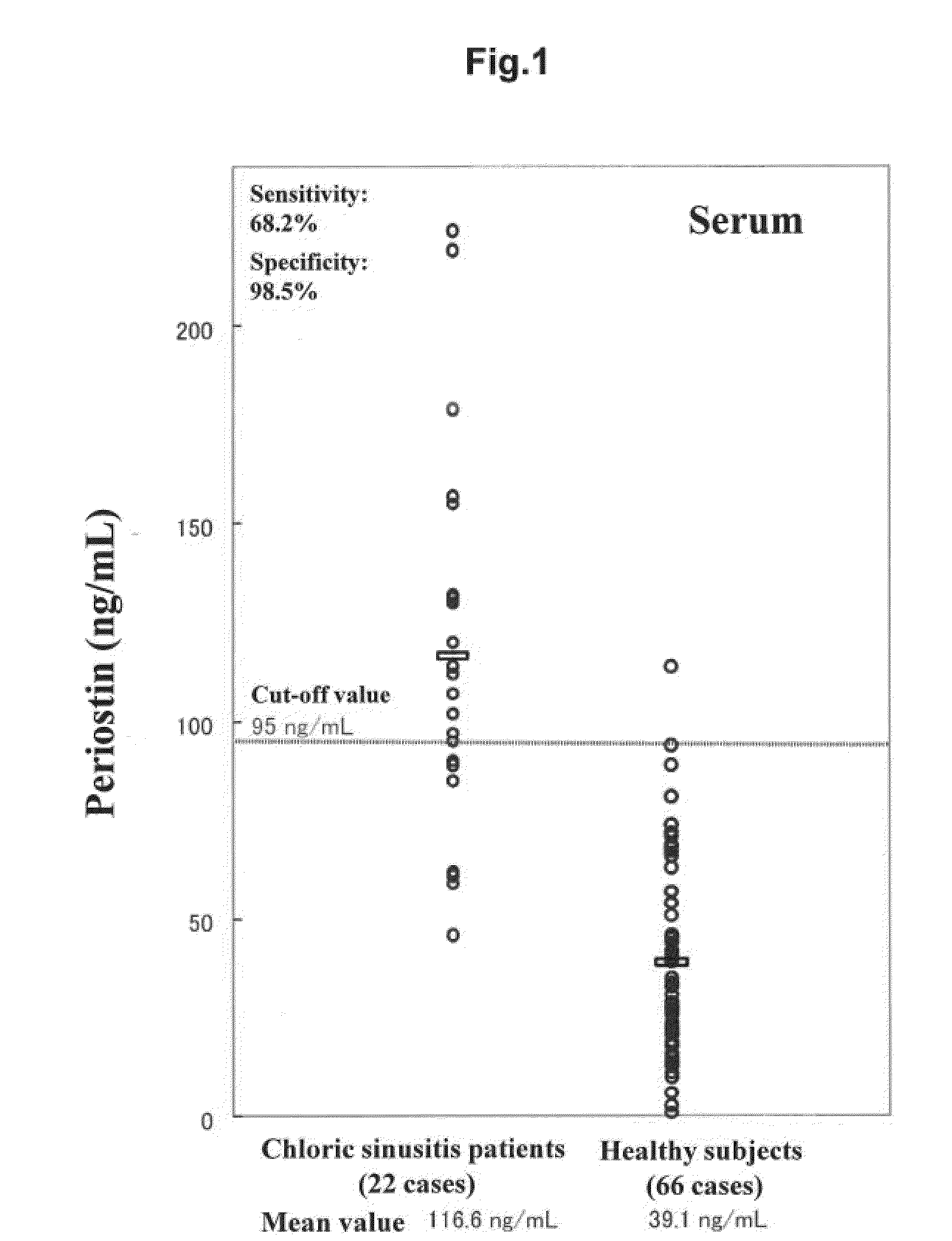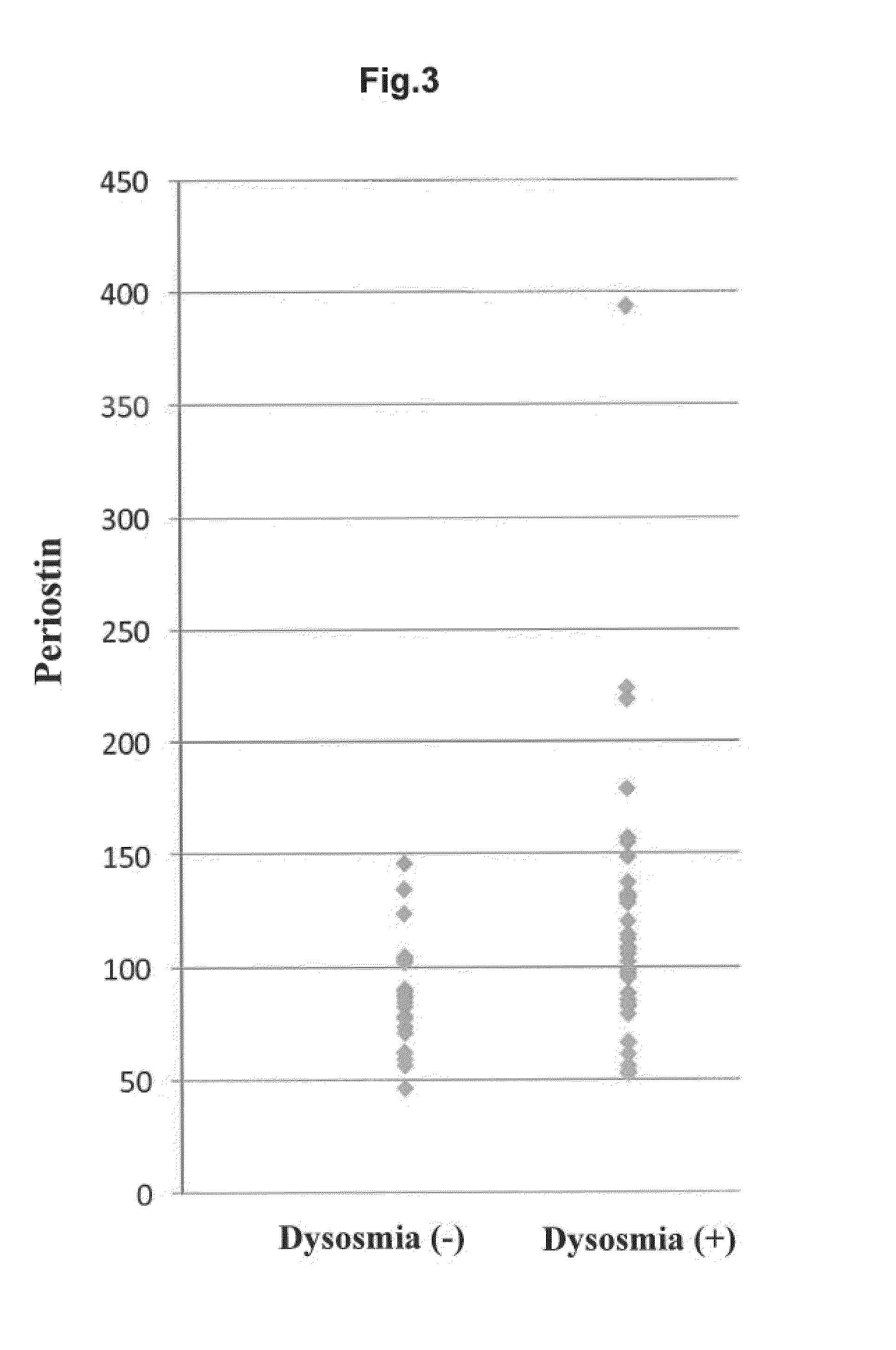Method for diagnosing chronic sinusitis
a sinusitis and chronic sinusitis technology, applied in the field of chronic sinusitis detection, can solve the problems of difficult to distinguish allergic sinusitis from chronic sinusitis based on subjective findings, methods that are not necessarily simple, and patients are placed with a great burden, so as to achieve less burden on patients and different analytical values
- Summary
- Abstract
- Description
- Claims
- Application Information
AI Technical Summary
Benefits of technology
Problems solved by technology
Method used
Image
Examples
example 1
[0095]Serum periostin concentration in the blood collected from test subjects, from whom informed consent had previously been obtained, was analyzed as follows according to an ELISA method using an anti-periostin antibody.
[0096]First, 100 μl of SS18A (rat monoclonal anti-periostin antibody) diluted to a concentration of 2 μg / mL with phosphate-buffered saline (PBS) (an aqueous solution (pH 7.4) containing 137 mM sodium chloride, 2.68 mM potassium chloride, 1.47 mM potassium dihydrogen phosphate and 8.04 mM disodium hydrogen phosphate) was poured into each well of a 96-well plate for ELISA, and it was then left at rest at 25° C. for 12 hours or longer, so that SS18A was adsorbed on the bottom of each well. Thereafter, the well was washed with washing solution (PBS containing 0.05% Tween-20) three times, and 250 μl of blocking solution (50 mM Tris buffer (pH 8.0) containing 0.5% casein, 100 mM sodium chloride, and 0.1% sodium azide) was then poured into the resulting well. The well was...
example 2
[0106]In the present example, nasal lavage fluid collected from test subjects, from whom informed consent had previously been obtained, was used as nasal secretion, and the periostin concentration in the nasal lavage fluid was analyzed.
[0107]Collection and preparation of the nasal lavage fluid for the measurement of the periostin concentration were specifically carried out as follows. First, using a syringe, 10 ml of normal saline was directly injected into each patient. even though the syringe was not necessarily inserted into the posterior part of the nasal cavity, injection of normal saline could be sufficiently carried out with water pressure originating from the syringe. The patient was allowed to hold a kidney basin and to tilt his or her face downward, so that the normal saline injected into the nasal cavity could flow through the nasal cavities on both sides and the oral cavity into the kidney basin. The normal saline was recovered from the kidney basin using a dropper, and ...
example 3
[0117]In the present example, the relationship between the serum periostin concentration in blood derived from chronic sinusitis patients and the severity of chronic sinusitis was examined.
[0118]Examples of an index associated with the severity in the symptoms of chronic sinusitis include the presence or absence of dysosmia, the presence of absence of multiple polyps, the number of eosinophils, the presence or absence of the complication of allergies, and CT (Computed Tomography) scores. In a case in which dysosmia is present, in a case in which multiple adenomatous polyps are presents, in a case in which a large number of eosinophils are present, in a case in which the complication of allergies is present, or in a case in which the CT score is 10 or greater, the symptoms of chronic sinusitis are considered to be more severe.
(1) Relationship Between Serum Periostin Concentration and Dysosmia Score
[0119]FIG. 3 shows serum periostin concentrations in the following two patient groups,...
PUM
| Property | Measurement | Unit |
|---|---|---|
| Concentration | aaaaa | aaaaa |
| Concentration | aaaaa | aaaaa |
| Concentration | aaaaa | aaaaa |
Abstract
Description
Claims
Application Information
 Login to View More
Login to View More - R&D
- Intellectual Property
- Life Sciences
- Materials
- Tech Scout
- Unparalleled Data Quality
- Higher Quality Content
- 60% Fewer Hallucinations
Browse by: Latest US Patents, China's latest patents, Technical Efficacy Thesaurus, Application Domain, Technology Topic, Popular Technical Reports.
© 2025 PatSnap. All rights reserved.Legal|Privacy policy|Modern Slavery Act Transparency Statement|Sitemap|About US| Contact US: help@patsnap.com



